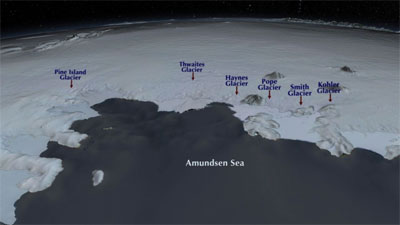Just as the International Energy Agency warns about the "bleak" progress on climate change …
Two studies find the collapse of the enormous West Antarctic ice sheet is inevitable and unstoppable, ensuring world sea level rise of 4-12 feet. At 10 feet higher, the ocean would consume 28,800 square miles of US land, where 12.3 million people live today.
The Thwaites Glacier, which holds the massive West Antarctic Ice Sheet together – the size of Arizona and New Mexico combined – is collapsing.
Current thinking is it will happen slowly over the next 200-400 years, but as is the case for climate change impacts generally, this too is occurring much faster than predicted.

Because of warmer water and changing winds from global warming and the ozone hole, the "underbelly" of the Antarctic is weak allowing water to flow through, melting the ice faster. After looking at 40 years of data, lead author Ian Joughin, a glaciologist at the University of Washington told Associated Press, "We really are witnessing the beginning stages."
"The system is in a chain reaction that is unstoppable," says Eric Rignot, lead author of a NASA study and a glacial scientist at University of California Irvine. At this point, even if fossil fuel emissions stopped, the melting would likely continue, but at a slower pace, he says. "Think of it is like wine flowing from a horizontal uncorked bottle."
"It’s bad news. It’s a game changer," Ted Scambos, lead scientist at the National Snow and Ice Data Center, told Associated Press. "We thought we had a while to wait and see. We’ve started down a process that we always said was the biggest worry and biggest risk from West Antarctica."
So far, scientists predict the melt will be slow, about 3 feet by 2100 caused by this one ice sheet. But another ice sheet broke off last November and combined with melt in Greenland and the Arctic, we’re clearly going to see significant sea level rise during this century.
If there’s a silver lining, it’s that the much larger East Antarctic ice sheet seems to be stable.
Impact on Australia
Shifting winds are also behind Australia’s severe, extended drought. Over the past 25 years, Southern Ocean winds have been shifting away from South Australia – which brings rain – toward Antarctica instead.
And "they are now stronger than at any other time in the last 1000 years," says Nerilie Abram, from Australian National University’s Research School of Earth Sciences. "It’s not good news. As greenhouse gases continue to rise, we’ll get fewer storms chased up into Australia. As the westerly winds are getting tighter, they’re actually trapping more of the cold air over Antarctica." That’s why Antarctica hasn’t been melting as quickly as the Arctic.
US Cities with the most people on threatened land:
New York
New Orleans
Miami
Hialeah, FL
Virginia Beach
Fort Lauderdale
Norfolk
Stockton, CA.
Metairie, LA
Hollywood, FL.
See these maps on what sea level rise looks like:
